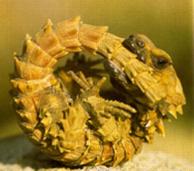

Genus: Cordylus
Species: cataphractus

The nostrils of the Armadillo Lizard are formed into little tubes. The tubes help the Armadillo Lizards smell for food or predators. A ground dwelling lizard, it is active in the daytime and feeds on a wide variety of insects, as well as on spiders and other invertebrates. The head of the Armadillo Lizard is narrow in shape. It is fairly slow moving animal, but when the Armadillo Lizard thinks or knows it's in danger, it runs as fast as it can go for cover.
The body length is 15-17 inches, the tail is 14-16 inches long, and it weighs 8-17 lbs. Its back legs are a little shorter than the front. The head, body, and club-like tail are all flattened, enabling it to wriggle easily into rock crevices for shelter. It may also adopt a curious defensive posture when threatened by rolling itself up like an Armadillo, with its tail tightly held in its jaws, presenting a spiny ring to the predator and protecting the softer, vulnerable belly area. That's why its called the Armadillo Lizard. The armored Armadillo Lizard has protection all around its body so that predators can't harm any of its under parts. Also squeeze into small places for escape. Another protection is their spiny scales that go all the way around its body. Their tails and spines also can be used to defend themselves as well. The Armadillo Lizard can be found in the deserts of the southern tip of Africa.
The Armadillo Lizard has its babies in the late summer. Only 1 or 2 babies are born during that time. The Armadillo Lizards stay in family groups, and they will all live in the same rock crevice. When the lizards give birth, the babies are live-born, but do have a thin membranous shell that they need to break through.
The Armadillo Lizard is a prey animal. It is preyed upon by bigger and stronger predators, such as humans, etc. The Armadillo Lizard's armor is most usefull against many birds, mammals, and other reptiles.
The Armadillo Lizard is not an endangered species although it does have a lot of enemies to protect itself from. The Cape Provincial Ordinance helps the Armadillo Lizards when their injured or sick. That way the Armadillo lizards can be less endangered.
Zach S. 2001
Bibliography:
"Desert Biome.", http://mbgnet.mobot.org/sets/desert/animals/arma.htm.
"Cordylus
Cataphractus.", http://home.swipnet.se/tallbo/andra_cordylus/cordyluscataphractu
s.htm
"Lizards of the World; Armadillo.", http://www.discovery.com/exp/lizards/low_armadillo.html
"Reaction to
danger", http://www.britannica.com/eb/article?eu=118991&hook=421391#4
21391.hook
Photo credit: Pictures from Bill Branch´s "Field Guide to the Snakes and other Reptiles of Southern Africa."- Cape Town : Struik Publishers,326s, BRANCH WILLIAM R.(1988g), page 157 - 164.